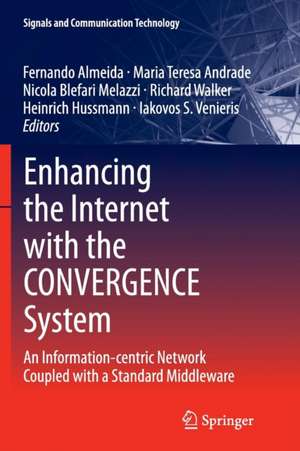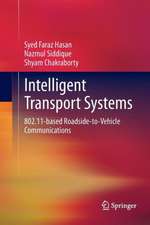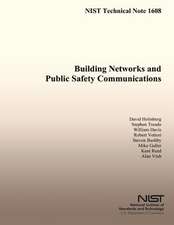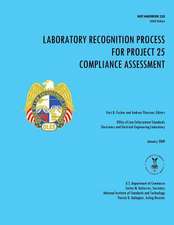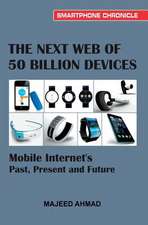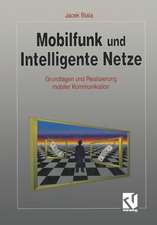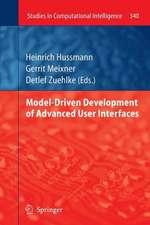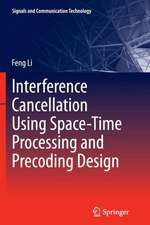Enhancing the Internet with the CONVERGENCE System: An Information-centric Network Coupled with a Standard Middleware: Signals and Communication Technology
Editat de Fernando Almeida, Maria Teresa Andrade, Nicola Blefari Melazzi, Richard Walker, Heinrich Hussmann, Iakovos S. Venierisen Limba Engleză Paperback – 27 aug 2016
· definition of the VDI as a new fundamental unit of distribution and transaction;
· content-centric networking functionality to complement or replace IP-address-based routing;
· security and privacy protection mechanisms;
· open-source middleware, including a community dictionary service to enable rich semantic searches;
· applications, tested under real-life conditions.
This book shows how CONVERGENCE allows publishing, searching and subscribing to any content. Creators can publish their content by wrapping it and its descriptions into a VDI, setting rights for other users to access this content, monitor its use, and communicate with people using it; they may even update or revoke content previously published. Access to content is more efficient, as search engines exploit VDI metadata for indexing, and the network uses the content name to ensure users always access the copy closest to them. Every node in the network is a content cache; handover is easy; multicast is natural; peer-to-peer is built-in; time/space-decoupling is possible. Application developers can exploit CONVERGENCE’s middleware and network without having to resort to proprietary/ad hoc solutions for common/supporting functionality. Operators can use the network more efficiently, better controlling information transfer and related revenues flows. Network design, operation and management are simplified by integrating diverse functions and avoiding patches andstopgap solutions.
Whether as a text for graduate students working on the future of the Internet, or a resource for practitioners providing e-commerce or multimedia services, or scientists defining new technologies, CONVERGENCE will make a valuable contribution to the future shape of the Internet.
| Toate formatele și edițiile | Preț | Express |
|---|---|---|
| Paperback (1) | 835.45 lei 6-8 săpt. | |
| SPRINGER LONDON – 27 aug 2016 | 835.45 lei 6-8 săpt. | |
| Hardback (1) | 646.43 lei 6-8 săpt. | |
| SPRINGER LONDON – 12 dec 2013 | 646.43 lei 6-8 săpt. |
Din seria Signals and Communication Technology
- 18%
 Preț: 952.89 lei
Preț: 952.89 lei - 18%
 Preț: 1559.80 lei
Preț: 1559.80 lei - 17%
 Preț: 361.80 lei
Preț: 361.80 lei - 18%
 Preț: 811.61 lei
Preț: 811.61 lei - 15%
 Preț: 585.26 lei
Preț: 585.26 lei - 18%
 Preț: 727.97 lei
Preț: 727.97 lei - 15%
 Preț: 585.90 lei
Preț: 585.90 lei -
 Preț: 393.35 lei
Preț: 393.35 lei - 20%
 Preț: 1002.72 lei
Preț: 1002.72 lei - 15%
 Preț: 641.71 lei
Preț: 641.71 lei - 20%
 Preț: 338.91 lei
Preț: 338.91 lei - 18%
 Preț: 1579.66 lei
Preț: 1579.66 lei - 18%
 Preț: 896.08 lei
Preț: 896.08 lei - 18%
 Preț: 847.11 lei
Preț: 847.11 lei - 18%
 Preț: 1234.77 lei
Preț: 1234.77 lei - 18%
 Preț: 905.54 lei
Preț: 905.54 lei - 15%
 Preț: 646.43 lei
Preț: 646.43 lei - 20%
 Preț: 662.48 lei
Preț: 662.48 lei - 15%
 Preț: 641.20 lei
Preț: 641.20 lei - 18%
 Preț: 1847.84 lei
Preț: 1847.84 lei - 18%
 Preț: 946.24 lei
Preț: 946.24 lei - 18%
 Preț: 1241.10 lei
Preț: 1241.10 lei - 20%
 Preț: 649.43 lei
Preț: 649.43 lei - 20%
 Preț: 993.28 lei
Preț: 993.28 lei - 18%
 Preț: 940.57 lei
Preț: 940.57 lei - 18%
 Preț: 1389.30 lei
Preț: 1389.30 lei - 20%
 Preț: 1003.50 lei
Preț: 1003.50 lei - 18%
 Preț: 953.52 lei
Preț: 953.52 lei - 20%
 Preț: 1001.16 lei
Preț: 1001.16 lei - 18%
 Preț: 1415.36 lei
Preț: 1415.36 lei - 15%
 Preț: 653.33 lei
Preț: 653.33 lei - 15%
 Preț: 645.60 lei
Preț: 645.60 lei - 15%
 Preț: 637.28 lei
Preț: 637.28 lei - 18%
 Preț: 948.79 lei
Preț: 948.79 lei - 18%
 Preț: 945.62 lei
Preț: 945.62 lei - 18%
 Preț: 836.36 lei
Preț: 836.36 lei - 18%
 Preț: 1230.84 lei
Preț: 1230.84 lei - 15%
 Preț: 635.01 lei
Preț: 635.01 lei - 15%
 Preț: 639.25 lei
Preț: 639.25 lei - 15%
 Preț: 646.30 lei
Preț: 646.30 lei - 15%
 Preț: 639.25 lei
Preț: 639.25 lei - 15%
 Preț: 712.36 lei
Preț: 712.36 lei - 20%
 Preț: 1006.12 lei
Preț: 1006.12 lei - 18%
 Preț: 970.56 lei
Preț: 970.56 lei
Preț: 835.45 lei
Preț vechi: 1018.85 lei
-18% Nou
Puncte Express: 1253
Preț estimativ în valută:
159.88€ • 165.17$ • 133.06£
159.88€ • 165.17$ • 133.06£
Carte tipărită la comandă
Livrare economică 26 martie-09 aprilie
Preluare comenzi: 021 569.72.76
Specificații
ISBN-13: 9781447170372
ISBN-10: 1447170377
Pagini: 275
Ilustrații: XVI, 275 p. 98 illus., 92 illus. in color.
Dimensiuni: 155 x 235 x 15 mm
Greutate: 0.41 kg
Ediția:Softcover reprint of the original 1st ed. 2014
Editura: SPRINGER LONDON
Colecția Springer
Seria Signals and Communication Technology
Locul publicării:London, United Kingdom
ISBN-10: 1447170377
Pagini: 275
Ilustrații: XVI, 275 p. 98 illus., 92 illus. in color.
Dimensiuni: 155 x 235 x 15 mm
Greutate: 0.41 kg
Ediția:Softcover reprint of the original 1st ed. 2014
Editura: SPRINGER LONDON
Colecția Springer
Seria Signals and Communication Technology
Locul publicării:London, United Kingdom
Cuprins
Approaches for the Development of Information-Centric Networks.- Convergence Architecture: A Concise Overview.- The Network Level (CoNet).- The Content Level (CoMid).- The Versatile Digital Item (VDI).- The Convergence Security Infrastructure.- The Adoption of Rights Expression Language in CONVERGENCE.- Scenarios and Trials for CONVERGENCE.- Business Models and Exploitation.- Conclusions and Future Research Topics.
Notă biografică
Fernando Almeida is a Post-Doc Researcher in the field of Multimedia Applications and Future Media Services. He has participated as IT researcher in international projects such as ENTHRONE II, VISNET and XPRESS. He already worked as project engineer in IT companies such as Critical Software and Qimonda. His research interests includes multimedia networked applications, distributed content management, information systems and innovation policies. Relevant Publications: Almeida, F., "Creation of Value with Open Source Software in the Telecom Field: How to Profit from Open Source?", LAP Lambert, Saarbrücken, Germany, 2012. Hang, A., Almeida, F., Castro, H., Andrade, M., Chiariglione, L., Melazzi, N. and Hubmann, H., "Converging Podcasts: A Proposal for a Content-Centric Approach for Social Learning Environments", IEEE International Conference on Information Society (i-Society 2012), London, UK, 2012. Almeida, F., "Web 2.0 Technologies and Social Networking Security Fears in Enterprises", International Journal of Advanced Computer Science and Applications, New York, USA, Vol. 3, No. 2, 2012.
Castro, H., Almeida, F., Andrade, T., Tropea, G., Melazzi, N. and Chiariglione, L., "Exploring Semantic Relationships Across Internet Resources", International Conference on Next Generation Web Services Practices (NWeSP 2011), Salamanca, 2011. Maria Teresa Andrade is an Assistant Professor at the University of Porto - Faculty of Engineering, in the Electrotechnical and Computing Department. She is also a research engineer at INESC Porto, leading the Multimedia Area in the Telecommunications and Multimedia Unit. Her research at INESC Porto is mostly conducted within the framework of European funded projects. She has been involved in such projects since 1991. Relevant Publications: M. T. Andrade, S. Dogan, V. Barbosa, H. Kodikara, A. Carreras, J. Delgado, A. Kondoz, "Delivery of sensitive multimedia content serving user's expectations", ACM Transactions on MultimediaComputing Communications and Applications Journal, 2010. V. Rodriguez, A. Carreras, V. Barbosa, J. Delgado, M. T. Andrade, “A Semantic Model for the Authorisation of Context-Aware Content Adaptation”, in Proceedings of the 3rd International Conference on Semantic and Digital Media Technologies (SAMT 2008), Koblenz, Germany, December 2008. Timmerer C., Lugmayr A., Mackay M., Lindsay A., Fang L., Mehaoua A., SibidŽ M., Andrade M., Castro H., Carvalho P., Souto P., “An Integrated Management Supervisor for End-to-End Management of Heterogeneous Contents, Networks, and Terminals enabling Quality of Service”, in Proceedings of the nd European Symposium on Mobile Media Delivery (EUMOB) 2008, Oulu, Finland, July 2008. Nicola Blefari-Melazzi is a Full Professor of Telecommunications at the University of Rome “Tor Vergata”, Italy. He is the Director of the Department of Electronic Engineering. Dr. Blefari-Melazzi has participated in over 20 international projects and is or has been the coordinator of three EU-funded projects. He has been an evaluator for many research proposals (both in the 6th and in the 7th EU FPs) and has been a reviewer for numerous EU and ITEA sponsored projects. He is author/co-author of about 160 papers, in international journals and conference proceedings. His research interests lie mainly in the performance evaluation, design and control of telecommunications networks. Relevant Publications:
A. Baiocchi, N. Blefari-Melazzi, M. Listanti, A. Roveri, R. Winkler: “Loss performance analysis of an ATM multiplexer loaded with high speed on-off sources”, IEEE Journal on Selected Areas in Communications, Vol. 9, N. 3, April 1991, pp. 388-393.
N. Blefari-Melazzi, D. Di Sorte, M. Femminella, G. Reali: “Autonomic Control and Personalization of a Wireless Access Network”, Computer Networks, Elsevier, Volume 51, Issue 10, 11 July 2007, pp. 2645-2676. G. Bianchi, N. Blefari Melazzi, L. Bracciale, F. Lo Piccolo, S. Salsano:“Streamline: an Optimal Distribution Algorithm for Peer-to-Peer Real-time Streaming”, IEEE Transactions on Parallel and Distributed Systems., ISSN: 1045-9219, doi.ieeecomputersociety.org/10.1109/TPDS.2009.114, June 2010. Richard Walker founded Xiwrite in 2000 and was the company’s Managing Director from then until February 2010. Originally an economist, he has worked many years in IT, first as a manager in Unisys and in the Telecom Italia group and then as an academic and as a consultant specialized in collaborative research. From 2006-2009 he led Xiwrite efforts in the SMS, PASION and Neurovers-IT projects. From 2004-5 he was personal assistant to the Coordinator in the Simplicity Project. From 2003-5 he was scientific coordinator of the European funded I-Learning Project. In parallel with this work he has maintained a strong interest in IT. From 1999 to 2003 he was a lecturer at the Faculty of Psychology at Università di Napoli II, teaching courses on “Artificial Intelligence” and “Data Analysis”. In 2005 he was guest professor at University of Cologne. In February 2010 he left his position as Managing Director to take on a a Senior Consultant position. He maintains his position as the company’s legal representative. Relevant Publications:
Walker R. , Preserving Personal Autonomy in a World of “Augmented Communications”: Technology, Law and Personal Behavior, Ethics and Information Technology (in print), 2010
Walker R., Gamberini L., Spagnolli, A, Editorial Preface to Psychonology Journal 7:1, special issue on “Ethics in Presence and Social Presence Technologies”, 2009. Bartolomeo G., Blefari Melazzi N., Salsano S., Walker R.: “Design and Implementation of Mobile Electronic Memos: a tool to capture and share information in mobile environments”, ICT-MobileSummit 2009, 10 – 12 June 2009, Santander, Spain. De Sanctis, M., Werner M., Walker R., Boutroux V. , Patesti M. “Business Models and charging for mobile services inthe air travel value chain”, 16th IST Mobile & Wireless Communications Summit 2007, Budapest, Hungary, 1-5 July, 2007
Broll G., Walker R., Patesti M., Boring S., “Acceptance and Use of Simple Mobile Services – Preliminary Results and Perspectives“, Workshop MobileInternetUX, in conjunction with the 9th International Conference on Human Computer Interaction with Mobile Devices and Services (MobileHCI) 2007, Singapore, September 9, 2007.
Castro, H., Almeida, F., Andrade, T., Tropea, G., Melazzi, N. and Chiariglione, L., "Exploring Semantic Relationships Across Internet Resources", International Conference on Next Generation Web Services Practices (NWeSP 2011), Salamanca, 2011. Maria Teresa Andrade is an Assistant Professor at the University of Porto - Faculty of Engineering, in the Electrotechnical and Computing Department. She is also a research engineer at INESC Porto, leading the Multimedia Area in the Telecommunications and Multimedia Unit. Her research at INESC Porto is mostly conducted within the framework of European funded projects. She has been involved in such projects since 1991. Relevant Publications: M. T. Andrade, S. Dogan, V. Barbosa, H. Kodikara, A. Carreras, J. Delgado, A. Kondoz, "Delivery of sensitive multimedia content serving user's expectations", ACM Transactions on MultimediaComputing Communications and Applications Journal, 2010. V. Rodriguez, A. Carreras, V. Barbosa, J. Delgado, M. T. Andrade, “A Semantic Model for the Authorisation of Context-Aware Content Adaptation”, in Proceedings of the 3rd International Conference on Semantic and Digital Media Technologies (SAMT 2008), Koblenz, Germany, December 2008. Timmerer C., Lugmayr A., Mackay M., Lindsay A., Fang L., Mehaoua A., SibidŽ M., Andrade M., Castro H., Carvalho P., Souto P., “An Integrated Management Supervisor for End-to-End Management of Heterogeneous Contents, Networks, and Terminals enabling Quality of Service”, in Proceedings of the nd European Symposium on Mobile Media Delivery (EUMOB) 2008, Oulu, Finland, July 2008. Nicola Blefari-Melazzi is a Full Professor of Telecommunications at the University of Rome “Tor Vergata”, Italy. He is the Director of the Department of Electronic Engineering. Dr. Blefari-Melazzi has participated in over 20 international projects and is or has been the coordinator of three EU-funded projects. He has been an evaluator for many research proposals (both in the 6th and in the 7th EU FPs) and has been a reviewer for numerous EU and ITEA sponsored projects. He is author/co-author of about 160 papers, in international journals and conference proceedings. His research interests lie mainly in the performance evaluation, design and control of telecommunications networks. Relevant Publications:
A. Baiocchi, N. Blefari-Melazzi, M. Listanti, A. Roveri, R. Winkler: “Loss performance analysis of an ATM multiplexer loaded with high speed on-off sources”, IEEE Journal on Selected Areas in Communications, Vol. 9, N. 3, April 1991, pp. 388-393.
N. Blefari-Melazzi, D. Di Sorte, M. Femminella, G. Reali: “Autonomic Control and Personalization of a Wireless Access Network”, Computer Networks, Elsevier, Volume 51, Issue 10, 11 July 2007, pp. 2645-2676. G. Bianchi, N. Blefari Melazzi, L. Bracciale, F. Lo Piccolo, S. Salsano:“Streamline: an Optimal Distribution Algorithm for Peer-to-Peer Real-time Streaming”, IEEE Transactions on Parallel and Distributed Systems., ISSN: 1045-9219, doi.ieeecomputersociety.org/10.1109/TPDS.2009.114, June 2010. Richard Walker founded Xiwrite in 2000 and was the company’s Managing Director from then until February 2010. Originally an economist, he has worked many years in IT, first as a manager in Unisys and in the Telecom Italia group and then as an academic and as a consultant specialized in collaborative research. From 2006-2009 he led Xiwrite efforts in the SMS, PASION and Neurovers-IT projects. From 2004-5 he was personal assistant to the Coordinator in the Simplicity Project. From 2003-5 he was scientific coordinator of the European funded I-Learning Project. In parallel with this work he has maintained a strong interest in IT. From 1999 to 2003 he was a lecturer at the Faculty of Psychology at Università di Napoli II, teaching courses on “Artificial Intelligence” and “Data Analysis”. In 2005 he was guest professor at University of Cologne. In February 2010 he left his position as Managing Director to take on a a Senior Consultant position. He maintains his position as the company’s legal representative. Relevant Publications:
Walker R. , Preserving Personal Autonomy in a World of “Augmented Communications”: Technology, Law and Personal Behavior, Ethics and Information Technology (in print), 2010
Walker R., Gamberini L., Spagnolli, A, Editorial Preface to Psychonology Journal 7:1, special issue on “Ethics in Presence and Social Presence Technologies”, 2009. Bartolomeo G., Blefari Melazzi N., Salsano S., Walker R.: “Design and Implementation of Mobile Electronic Memos: a tool to capture and share information in mobile environments”, ICT-MobileSummit 2009, 10 – 12 June 2009, Santander, Spain. De Sanctis, M., Werner M., Walker R., Boutroux V. , Patesti M. “Business Models and charging for mobile services inthe air travel value chain”, 16th IST Mobile & Wireless Communications Summit 2007, Budapest, Hungary, 1-5 July, 2007
Broll G., Walker R., Patesti M., Boring S., “Acceptance and Use of Simple Mobile Services – Preliminary Results and Perspectives“, Workshop MobileInternetUX, in conjunction with the 9th International Conference on Human Computer Interaction with Mobile Devices and Services (MobileHCI) 2007, Singapore, September 9, 2007.
Textul de pe ultima copertă
Convergence proposes the enhancement of the Internet with a novel, content-centric, publish–subscribe service model based on the versatile digital item (VDI): a common container for all kinds of digital content, including digital representations of real-world resources. VDIs will serve the needs of the future Internet, providing a homogeneous method for handling structured information, incorporating security and privacy mechanisms. CONVERGENCE subsumes the following areas of research:
· definition of the VDI as a new fundamental unit of distribution and transaction;
· content-centric networking functionality to complement or replace IP-address-based routing;
· security and privacy protection mechanisms;
· open-source middleware, including a community dictionary service to enable rich semantic searches;
· applications, tested under real-life conditions.
This book shows how CONVERGENCE allows publishing, searching and subscribing to any content. Creators can publish their content by wrapping it and its descriptions into a VDI, setting rights for other users to access this content, monitor its use, and communicate with people using it; they may even update or revoke content previously published. Access to content is more efficient, as searchengines exploit VDI metadata for indexing, and the network uses the content name to ensure users always access the copy closest to them. Every node in the network is a content cache; handover is easy; multicast is natural; peer-to-peer is built-in; time/space-decoupling is possible. Application developers can exploit CONVERGENCE’s middleware and network without having to resort to proprietary/ad hoc solutions for common/supporting functionality. Operators can use the network more efficiently, better controlling information transfer and related revenues flows. Network design, operation and management are simplified by integrating diverse functions and avoiding patches and stopgap solutions.
Whether as a text for graduate students working on the future of the Internet, or a resource for practitioners providing e-commerce or multimedia services, or scientists defining new technologies, CONVERGENCE will make a valuable contribution to the future shape of the Internet.
· definition of the VDI as a new fundamental unit of distribution and transaction;
· content-centric networking functionality to complement or replace IP-address-based routing;
· security and privacy protection mechanisms;
· open-source middleware, including a community dictionary service to enable rich semantic searches;
· applications, tested under real-life conditions.
This book shows how CONVERGENCE allows publishing, searching and subscribing to any content. Creators can publish their content by wrapping it and its descriptions into a VDI, setting rights for other users to access this content, monitor its use, and communicate with people using it; they may even update or revoke content previously published. Access to content is more efficient, as searchengines exploit VDI metadata for indexing, and the network uses the content name to ensure users always access the copy closest to them. Every node in the network is a content cache; handover is easy; multicast is natural; peer-to-peer is built-in; time/space-decoupling is possible. Application developers can exploit CONVERGENCE’s middleware and network without having to resort to proprietary/ad hoc solutions for common/supporting functionality. Operators can use the network more efficiently, better controlling information transfer and related revenues flows. Network design, operation and management are simplified by integrating diverse functions and avoiding patches and stopgap solutions.
Whether as a text for graduate students working on the future of the Internet, or a resource for practitioners providing e-commerce or multimedia services, or scientists defining new technologies, CONVERGENCE will make a valuable contribution to the future shape of the Internet.
Caracteristici
Explains to the reader the nature of a new fundamental unit of distribution and transaction in network events Shows how new business models are made possible or facilitated by future Internet architecture Teaches the reader about the main concepts of information-centric network design: the paradigm of the future Offers a framework under which providers and consumers of digital content can use, authenticate, protect and revoke versatile digital items
